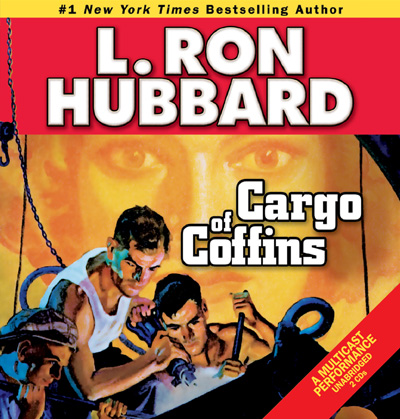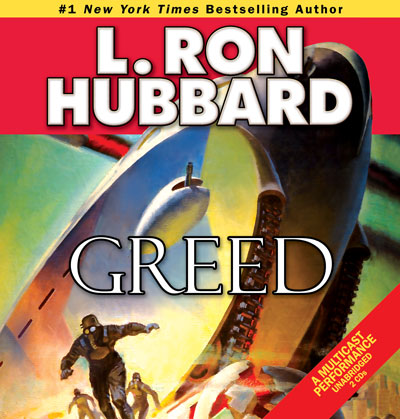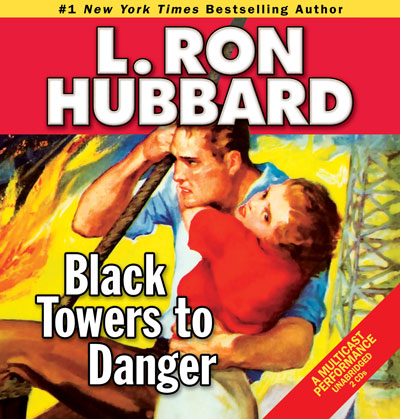US Navy Lieutenant Steve Craig is in one hell of a mess. Being accused of murder is bad enough, but the local police are convinced he’s killed his own father. And now, for Steve Craig, the plot is about to get down and dirty.
Steve’s safe from the cops as long as he stays aboard his Navy ship—but the word safe isn’t in his vocabulary. He slips off the vessel and vanishes into the seamy underside of the city, determined to find out who took his father’s life … even if it means risking his own.
He follows a trail of smoke and mirrors and sudden violence to the Brass Keys to Murder. With them, Steve will seek to unlock the terrible truth behind his father’s death … and an astonishing secret that will change his life—and that of the woman he loves—forever.
Performers: R.F. Daley (narrator), Bob Caso, Beth Leckbee, Jim Meskimen, and Jimmy Weldon.
SAMPLE
ABOUT THE AUTHOR
L. Ron Hubbard knew well the life at sea and the world surrounding it. Not only was he the son of a naval officer, but he also traveled back and forth across the Pacific, plied the China coast in a working schooner, and commanded an expedition aboard a four-masted ship to the Caribbean. He walked the waterfronts of countless ports, sharing stories with the colorful—and often shady—characters inhabiting them. Originally published in April 1935 under the pen name Michael Keith, Brass Keys to Murder is a direct result of those adventures.
Brass Keys to Murder Glossary
Stories from the Golden Age reflect the words and expressions used in the 1930s and 1940s, adding unique flavor and authenticity to the tales. While a character’s speech may often reflect regional origins, it also can convey attitudes common in the day. So that readers can better grasp such cultural and historical terms, uncommon words or expressions of the era, the following glossary has been provided.
bales: large bundles or packages prepared for shipping, storage, etc.
belay: stop.
belaying pin: a large wooden or metal pin that fits into a hole in a rail on a ship or boat, and to which a rope can be fastened.
bells: the strokes on a ship’s bell, every half-hour, to mark the passage of time.
Binnacle: a built-in housing for a ship’s compass. Used here as the name of a flophouse.
blackjack: a short, leather-covered club, consisting of a heavy head on a flexible handle, used as a weapon.
bluecoats: policemen.
bowler: derby; a hard felt hat with a rounded crown and narrow brim, created by James Lock & Co, a firm founded in 1676 in London. The prototype was made in 1850 for a customer of Lock’s by Thomas and William Bowler, hat makers in Southwark, England. At first it was dubbed the iron hat because it was hard enough to protect the head, and later picked up the name bowler because of its makers’ family name. In the US it became known as a derby from its association with the Kentucky Derby.
bracelets: a pair of handcuffs.
bucko: 1. a person who is domineering and bullying. 2. young fellow; chap; young companion.
camphor: camphor laurel; a large ornamental evergreen tree, native to Taiwan, Japan and some parts of China. It grows up to seventy feet tall and has leaves with a glossy, waxy appearance.
cargo boom: a long pole extending upward at an angle from the mast used to load and unload goods.
carronades: short cast-iron cannons. With their low muzzle velocity, their round shot was intended to create many deadly wooden splinters when hitting the structure of an enemy vessel, leading to the nickname “the smasher.”
cleats: strips of wood, iron or other material fastened across something to give strength, hold in position or furnish a grip.
clipper: a very fast sailing ship of the nineteenth century that had multiple masts and square sails.
Colón: a seaport in Panama at the Atlantic end of the Panama Canal.
coyote: used for a man who has the sneaking and skulking characteristics of a coyote.
cutlass: a short, heavy, slightly curved sword with a single cutting edge, formerly used by sailors.
dick: a detective.
doffed chapeaus: removal of one’s hat; following the rules of etiquette regarding the wearing of hats and when one should remove them.
dope: information, data or news.
fantail: a rounded overhanging part of a ship’s stern (the rear part of the ship).
flatfoot: a police officer; cop; a patrolman walking a regular beat.
flophouse: a cheap, run-down hotel or rooming house.
forty-five or .45 automatic: a handgun chambered to fire a .45-caliber cartridge and that utilizes the recoil or part of the force of the explosive to eject the spent cartridge shell, introduce a new cartridge, cock the arm and fire it repeatedly.
gangway: a narrow, movable platform or ramp forming a bridge by which to board or leave a ship.
G-men: government men; agents of the Federal Bureau of Investigation.
greenhorn: an easterner unacquainted with cowboy ways.
Guantánamo: Guantánamo Bay Naval Base at the southeastern end of Cuba. It has been used by the United States Navy since 1898 and is the oldest overseas US Navy base.
Gulf of Chihli: the innermost gulf of the Yellow Sea on the coast of northeastern China. Its proximity to Beijing, the capital of China, makes it one of the busiest seaways in the world.
gunwale: the upper edge of the side of a boat. Originally a gunwale was a platform where guns were mounted, and was designed to accommodate the additional stresses imposed by the artillery being used.
Haiti: country in the Caribbean occupying the western part of the island of Hispaniola. The other half is occupied by the Dominican Republic.
half-seas over: almost drunk.
halyard: a rope used for raising and lowering a sail.
hawser: a thick rope or cable for mooring or towing a ship.
Horn, the: Cape Horn; the southern tip of South America. The passage around Cape Horn is one of the most hazardous shipping routes in the world, however, the use of this route was greatly reduced by the opening of the Panama Canal in 1914. It is commonly known to sailors simply as the Horn.
Huangpu: a long river in China flowing through Shanghai. It is a major navigational route, lined with wharves, warehouses and industrial plants, and provides access to Shanghai for oceangoing vessels.
inboard: within the hull or toward the center of a vessel.
Insular Line: US shipping line established in 1904.
jake: satisfactory; okay; fine.
Judge Advocate General or JAG: senior legal advisor to a branch of the military.
Judge Colt: nickname for the single-action (that is, cocked by hand for each shot), six-shot Army model revolver first produced in 1873 by Colt Firearms Company, the armory founded by Samuel Colt (1814–1862). The handgun of the Old West became the instrument of both lawmaker and lawbreaker during the last twenty-five years of the nineteenth century. It soon earned various names, such as “Peacemaker,” “Equalizer,” and “Judge Colt and his jury of six.”
junks: seagoing ships with traditional Chinese designs and used primarily in Chinese waters. Junks have square sails, a high stern and usually a flat bottom.
keelhauled: a severe form of corporal punishment meted out to sailors at sea. The sailor was tied to a rope that looped beneath the vessel, thrown overboard on one side of the ship and dragged under the ship’s keel to the other side. As the hull was often covered with barnacles and other marine growth, this could result in lacerations and other injuries.
letters of mark and reprisal: a license to a private citizen to seize property of another nation.
lit out: left in a hurry.
midshipman: a student naval officer educated principally at sea.
oakum: loose hemp or jute fiber, sometimes treated with tar or asphalt, used chiefly for caulking seams in wooden ships.
outs, been on the: been estranged from another person; been unfriendly or on bad terms with.
painter: a rope, usually at the bow, for fastening a boat to a ship, stake, etc.
paper suitcase: an inexpensive suitcase made of hard cardboard.
privateersman: an armed ship that is privately owned and manned, commissioned by a government to fight or harass enemy ships.
ratlines: small ropes fastened horizontally between the shrouds in the rigging of a sailing ship to form ladder rungs for the crew going aloft.
rowels: the small spiked revolving wheels on the ends of spurs, which are attached to the heels of a rider’s boots and used to nudge a horse into going faster.
Scheherazade: the female narrator of The Arabian Nights, who during one thousand and one adventurous nights saved her life by entertaining her husband, the king, with stories.
scuttle: to sink a ship by making holes through the bottom.
shorthorn: a tenderfoot; a newcomer or a person not used to rough living and hardships.
slickers: swindlers; sly cheats.
slug: a bullet.
SS: steamship.
stanchion: an upright bar, post or frame forming a support or barrier.
stem to stern, from: from one end of the ship to the other or through the whole length.
superstructure: cabins and rooms above the deck of a ship.
Thames: a river of southern England flowing eastward to a wide estuary on the North Sea. Navigable for large ships as far as London, it is the principal commercial waterway of the country.
thirty-eight or .38: Police Positive .38; a .38-caliber revolver developed by the Colt Firearms Company in answer to a demand for a more powerful version of the .32-caliber Police Positive. First introduced in 1905, these guns were sold to many US police forces and European military units, as well as being made available to the general public.
thwart: a seat across a boat, especially one used by a rower.
twenty-five or .25 automatic: a small handgun chambered for the .25 ACP (Automatic Colt Pistol) cartridge designed by American firearms inventor John M. Browning (1855–1926).
USS: United States Steamship.
well deck: the space on the main deck of a ship lying at a lower level between the bridge and either a raised forward deck or a raised deck at the stern, which usually has cabins underneath.
West Indies rum: rum made by the West Indies Rum Distillery Limited. Established in 1893 by the Stades brothers, its primary purpose was to export rum to their homeland of Germany. Introducing the first still to the Caribbean, they were pioneers in scientific rum making.
wing collar: a shirt collar, used especially in men’s formal clothing, in which the front edges are folded down in such a way as to resemble a pair of wings.
Yellow Sea: an arm of the Pacific Ocean between the Chinese mainland and the Korean Peninsula. It connects with the East China Sea to the south.










